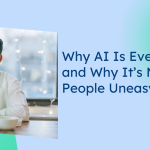In the fast-evolving landscape of artificial intelligence, where innovation meets practicality, SmythOS emerges as a game-changer. With a vision rooted in empowering human potential, SmythOS is not just another AI tool—it’s a platform designed to seamlessly integrate advanced AI capabilities into businesses of all sizes, making it accessible and scalable. After an in-depth conversation with Alexander De Ridder, the founder of SmythOS, it’s clear that this platform stands out with its thoughtful approach to solving real-world challenges faced by enterprises adopting AI.
Alexander’s passion for creating a platform that democratizes AI shines through his insights. From addressing the complexities of multi-agent orchestration to empowering users with no-code tools, SmythOS demonstrates a deep understanding of what businesses need today—and anticipates what they’ll require tomorrow. This interview provides valuable perspectives on how SmythOS is not only transforming AI integration but also redefining what’s possible in AI-driven business solutions.
Vision and Differentiation
Q1. SmythOS is built on a vision of enhancing human potential through AI. Could you elaborate on the foundational vision that drives SmythOS, and what inspired your approach to creating an AI operating system?
Alexander De Ridder:
The foundational vision behind SmythOS is to create a world where humans and AI collaborate seamlessly. I believe that AI should empower people, not replace them, by handling repetitive tasks and providing insights that allow us to focus on creativity and strategy. My background in AI and my experience with multi-agent systems showed me that the future isn’t about one-size-fits-all models but rather orchestrating specialized agents that work together autonomously. SmythOS was built to make this orchestration easy and accessible, allowing enterprises to integrate AI into their workflows without a steep learning curve. We wanted to tackle the core challenge of AI adoption by creating a platform where AI is intuitive, scalable, and tailored to specific needs.
Q2. SmythOS enables users to create and orchestrate AI agents with an impressive range of capabilities. In your view, what is the most significant challenge in AI agent creation today, and how does SmythOS address it?
Alexander De Ridder:
The biggest challenge in AI agent creation today is integration and scalability—many businesses struggle with deploying AI across different departments and systems. SmythOS addresses this by allowing users to orchestrate multiple AI agents that work together seamlessly across their organization. Our platform handles the complexities of integration, so whether you’re using AI for customer service, data analysis, or content generation, SmythOS makes it simple to deploy and manage. With SmythOS, businesses don’t have to worry about reinventing the wheel; instead, they can focus on leveraging AI to meet their unique needs.
Key Features and Technical Advantage

Q3. SmythOS’s multi-agent orchestration stands out as a core feature. Could you walk us through how this functionality is implemented and how it enables users to manage complex agent networks efficiently?
Alexander De Ridder:
Our multi-agent orchestration is designed to allow users to manage specialized AI agents that collaborate autonomously. Each agent is optimized for a specific function—whether it’s answering customer queries, analyzing data, or generating content. SmythOS acts as the conductor, coordinating these agents in real-time to ensure they’re working toward the organization’s goals. This orchestration allows businesses to scale AI across multiple departments effortlessly, providing a cohesive and adaptable AI infrastructure that grows with them. By using a multi-agent system, businesses can operate efficiently and handle complex tasks without getting bogged down in managing each AI individually.
Q4. The platform’s Agent Weaver AI and no-code visual studio allow for intuitive AI agent creation. How does SmythOS empower both technical and non-technical users to build sophisticated agents, and what role does user feedback play in refining these tools?
Alexander De Ridder:
Agent Weaver is one of the most exciting aspects of SmythOS because it allows users to create AI agents simply by chatting. Instead of navigating complex setup processes, users can describe their needs conversationally, and Agent Weaver translates those instructions into a fully functional AI agent. This means anyone—regardless of technical expertise—can create sophisticated agents in minutes. Combined with our no-code visual studio, which offers even more customization, we make AI accessible at every level of an organization. Feedback from users is crucial; we continuously refine these tools based on real-world use cases, ensuring that they’re intuitive, powerful, and adaptable to diverse needs.
Q5. Security and compliance are essential in enterprise AI applications. What are some of the advanced security protocols embedded in SmythOS, and how does the platform ensure data privacy and regulatory compliance for users with strict security requirements?
Alexander De Ridder:
Security and compliance are at the core of SmythOS’s design. We’ve embedded advanced encryption, data access controls, and user authentication to protect sensitive information. Additionally, SmythOS is designed to align with global regulatory standards, so businesses can trust that their data remains compliant with industry regulations. Many of our enterprise clients, especially in sectors with stringent security requirements, have expressed confidence in these measures. They appreciate that they can adopt AI while knowing that their data is secure and privacy standards are upheld.
User Impact and Market Reception
Q6. Since its launch, SmythOS has gained traction across various industries. Could you share some notable use cases or client stories that highlight the platform’s impact on operational efficiency and AI adoption?
Alexander De Ridder:
One of our clients, a manufacturer of smart dog collars, was struggling to keep up with a growing number of customer queries about order statuses, warranties, and returns. Their support team was overwhelmed, which led to delays and impacted the customer experience. By implementing a custom AI agent built with SmythOS, integrated seamlessly with their existing systems—Azure, WooCommerce, and AfterShip—they were able to transform their operations.
The results speak for themselves: the agent now handles over 500 queries daily, reducing response times by 80% and cutting support tickets by 70%. This has not only streamlined their customer support but also driven a noticeable increase in customer satisfaction. It’s a clear example of how SmythOS empowers businesses to enhance efficiency and deliver exceptional customer experiences through AI.
Q7. With SmythOS’s all-in-one approach to AI management, it seems well-suited for rapid adoption by enterprises. How has SmythOS been received in the market, and what feedback have you received from clients who transitioned to using it as a primary AI platform?
Alexander De Ridder:
SmythOS has been well-received in the market as an enterprise platform that unifies AI ecosystems, streamlines management, and ensures scalability, security, and compatibility. Clients have seen a reduction in deployment times by 90%, enabling rapid agent development in 2-4 weeks, improving productivity while lowering costs. And our scalability ensures organizations can grow their AI initiatives without operational silos, making it a trusted partner for transforming AI infrastructure across departments.
Future Direction and Broader Vision
Q8. Looking forward, what new functionalities or upgrades can users expect from SmythOS as it continues to grow?
Alexander De Ridder:
We’re focused on adding more advanced orchestration tools and enhanced agent collaboration capabilities to allow even greater flexibility and scalability. One of the upcoming features I’m excited about is adaptive learning agents—agents that can learn from interactions and refine their capabilities autonomously. This will allow users to deploy AI that becomes smarter over time, tailoring itself to their specific needs.
Q9. Finally, SmythOS embodies a mission to democratize AI tools and make them accessible to a global user base. How do you envision the platform’s impact on a broader scale, especially for users in emerging markets or small businesses?
Alexander De Ridder:
SmythOS was built with accessibility in mind—we want to democratize AI for businesses of all sizes, especially those in emerging markets or small to mid-sized businesses that don’t have the resources for traditional AI solutions. By providing no-code and low-cost options, SmythOS allows these users to compete on a level playing field. My hope is that SmythOS can bridge the AI gap, enabling businesses around the world to harness AI and drive innovation locally.
Conclusion
SmythOS exemplifies the transformative potential of AI when thoughtfully designed to meet real-world challenges. Its focus on multi-agent orchestration, ease of use, and robust security reflects Alexander De Ridder’s commitment to creating an inclusive and scalable platform. As AI adoption accelerates, SmythOS stands at the forefront, ensuring businesses of all sizes can unlock the true power of AI.
At AIPressRoom, we’re excited to witness how SmythOS continues to evolve and redefine the boundaries of AI integration, making it not only a tool for today but a cornerstone for the future of AI-driven business innovation.


